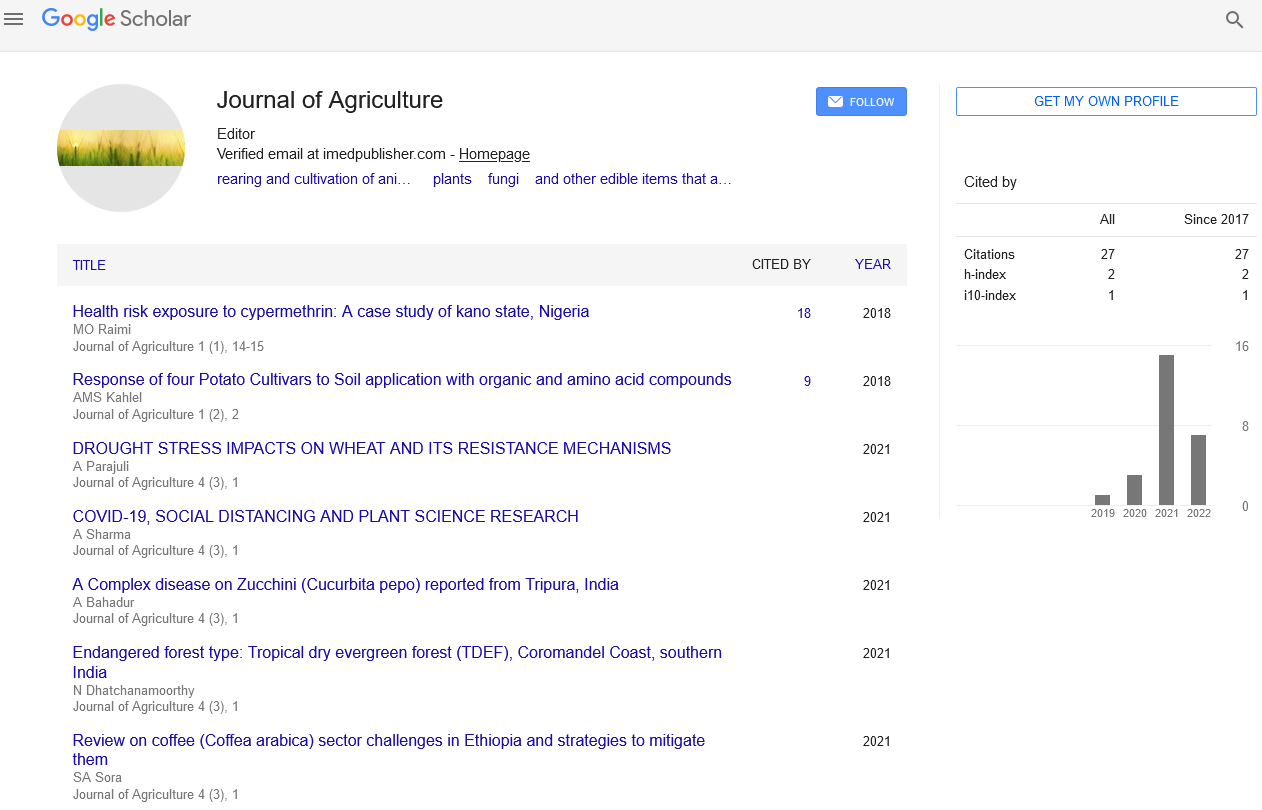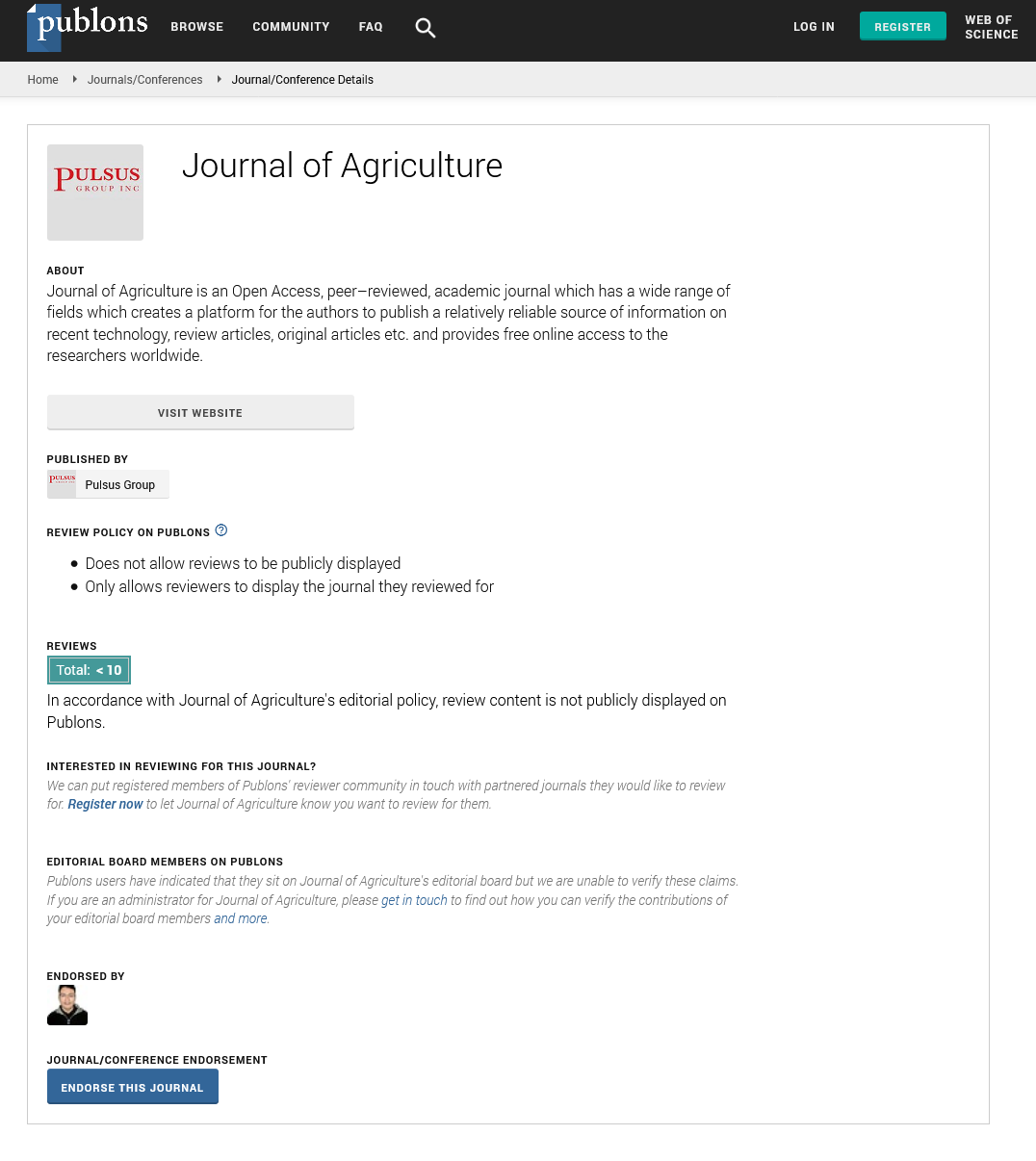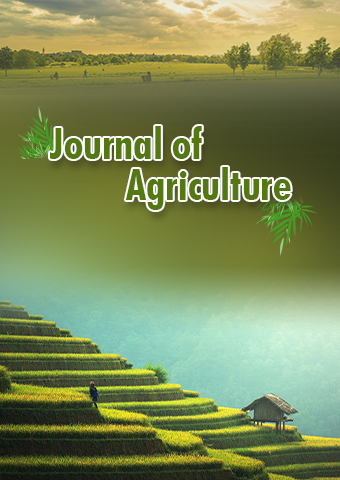Mini Review - Journal of Agriculture (2023) Volume 6, Issue 3
Revolutionizing Agriculture: The Role of Genetic Engineering
Sekhor Rajput*
Department of Economics, University of Dhaka, Bangladesh
Department of Economics, University of Dhaka, Bangladesh
E-mail: Rsekhor123@gmail.com
Received: 31-May-2023, Manuscript No. jagri-23-103208; Editor assigned: 02-Jun-2023, Pre-QC No. jagri-23-103208 (PQ); Reviewed: 16- Jun-2023, QC No. jagri-23-103208; Revised: 21-Jun-2023, Manuscript No. jagri-23-103208 (R); Published: 28-Jun-2023, DOI: 10.37532/ jagri.2023.6(3).82-84
Abstract
Genetic engineering, a rapidly evolving field of biotechnology, has emerged as a powerful tool in agriculture, offering promising solutions to various challenges faced by the global food production system. This abstract provides an overview of the advancements, implications, and future prospects of genetic engineering in agriculture. Genetic engineering in agriculture involves the manipulation of an organism’s genetic material to introduce desired traits or improve existing ones. This technology has facilitated the development of genetically modified crops (GMOs) that possess enhanced characteristics such as increased resistance to pests, diseases, and environmental stresses, improved nutritional content, and extended shelf life. Through the use of genetic engineering, scientists have been able to accelerate the breeding process and introduce traits that are not readily available through conventional breeding methods.The implications of genetic engineering in agriculture are multifaceted. On the positive side, GMOs have demonstrated the potential to increase crop yields, enhance food quality, and reduce post-harvest losses. They have also contributed to more sustainable agriculture by minimizing the need for chemical pesticides and herbicides, reducing soil erosion, and conserving water resources. Furthermore, genetic engineering has opened avenues for the production of crops with enhanced nutritional profiles, addressing nutritional deficiencies in vulnerable populations. The widespread adoption of genetic engineering in agriculture also raises important considerations. Environmental concerns regarding the potential impacts of GMOs on ecosystems, biodiversity, and the development of resistance in pests and weeds must be addressed. Social and ethical concerns, including consumer acceptance, labelling transparency, and the control of intellectual property rights, have also emerged as critical factors influencing the public perception and regulatory frameworks surrounding genetically modified crops.Looking ahead, the future prospects of genetic engineering in agriculture are promising. On-going research aims to further enhance crop traits, such as drought and heat tolerance, disease resistance, and nutritional content. Additionally, advances in synthetic biology and the development of gene drives hold potential for addressing pest and disease management challenges. Genetic engineering in agriculture has revolutionized the way we approach crop improvement and sustainable food production. While it presents opportunities for addressing global food security and environmental sustainability, careful consideration must be given to the potential risks and ethical implications. Continued research, regulation, and public dialogue are crucial for harnessing the full potential of genetic engineering in agriculture and ensuring its responsible and sustainable integration into our food systems
Keywords
Genetic engineering • Food production • Chemical pesticides • Ethical concerns
Introduction
Genetic engineering has emerged as a powerful tool in modern agriculture, enabling scientists to make precise modifications to the genetic makeup of plants and animals. This technology holds the potential to revolutionize the way we produce food, offering solutions to various challenges faced by farmers, consumers, and the environment. In this article, we will explore the applications of genetic engineering in agriculture and discuss both the benefits and concerns associated with this rapidly advancing field. Through the modification of specific genes, crops can be made more resistant to pests, diseases, and harsh environmental conditions. For example, by introducing a gene from a naturally pest-resistant plant into a susceptible crop, farmers can reduce the need for chemical pesticides, leading to lower costs and reduced environmental impact. Improving nutritional content genetic engineering has the potential to address malnutrition and nutrient deficiencies in the developing world. Scientists can modify crops to increase their nutritional value, such as enhancing vitamin content or improving protein quality. For instance, bio fortified crops, engineered to contain higher levels of essential micronutrients like iron and vitamin A, can help combat widespread deficiencies and improve public health [1-5].
Increasing crop yield
With the world’s population projected to reach 9 billion by 2050, ensuring food security is a paramount concern. Genetic engineering offers the possibility of increasing crop yields to meet growing demands. Through genetic modifications, crops can be engineered to produce higher yields, tolerate adverse conditions, and utilize resources more efficiently. This has the potential to alleviate pressure on agricultural land, minimize deforestation, and conserve biodiversity.
Disease resistance
Plant diseases can cause significant losses in crop production. Genetic engineering enables the development of disease-resistant crops, reducing the need for chemical fungicides and other control measures. By introducing genes that confer resistance to specific pathogens, such as bacteria, viruses, or fungi, scientists can create plants with improved natural defences. This approach can lead to higher yields, lower costs, and reduced environmental impact.
Environmental considerations
While genetic engineering offers numerous benefits, it is essential to address potential environmental concerns. Critics argue that genetically modified organisms (GMOs) may have unintended effects on ecosystems and biodiversity. It is crucial to conduct rigorous risk assessments and adopt responsible management strategies to mitigate any potential risks associated with the release of genetically modified organisms into the environment [6-10].
Regulatory frameworks
To ensure the safe and responsible use of genetic engineering in agriculture, regulatory frameworks are in place in many countries. These frameworks assess the potential risks and benefits of genetically modified crops and establish guidelines for their development, field testing, and commercialization. Ongoing research, public engagement, and transparent communication are crucial to maintain public trust and ensure the effective governance of this technology.
Conclusion
Genetic engineering holds immense promise for transforming agriculture and addressing various challenges related to food production, nutrition, and sustainability. By harnessing the power of genetic modification, scientists can develop crops with enhanced traits, improved nutritional content, and increased resistance to pests and diseases. However, it is vital to approach this technology with caution, considering potential environmental risks and adopting appropriate regulatory measures. With responsible and ethical use, genetic engineering in agriculture has the potential to shape a more sustainable and resilient food system for future generations.
References
- Reynolds A, Mann J, Cummings J et al. Carbohydrate quality and human health: a series of systematic reviews and meta-analyses. Lancet. 393, 434-445 (2019).
- Booth FW, Chakravarthy MV. Physical activity and dietary intervention for chronic diseases: a quick fix after all. J Appl Physiol. 100, 1439-40 (2006).
- Smith JG, Christophers AJ. Phenoxy herbicides and chlorophenols: a case control study on soft tissue sarcoma and malignant lymphoma. Br J Cancer. 65, 442-448 (1992).
- Hoar SK, Blair A, Holmes FF et al. Agricultural herbicide use and risk of lymphoma and soft-tissue sarcoma. JAMA. 256, 1141-1147 (1986).
- Merletti F, Richiardi L, Bertoni F et al. Occupational factors and risk of adult bone sarcomas: a multicentric case–control study in Europe. Int J Cancer.118, 721-727 (2006).
- Roberts CK, Won D, Pruthi S et al. Effect of a short-term diet and exercise intervention on oxidative stress, inflammation, MMP-9, and monocyte chemotactic activity in men with metabolic syndrome factors. J Appl Physiol. 100: 1657-65 (2006).
- Anderson JW, Ward K. High-carbohydrate, high-fiber diets for insulin-treated men with diabetes mellitus. Am J Clin Nutr. 32, 2312-21 (1979).
- AG Labortea, CAJM de Bie, EMA Smaling, et al. Rice yields and yield gaps in Southeast Asia: past trends and future outlook. Eur J Agron. 36, 9–20 (2012).
- E Birch, A Nicholas, Graham S Begg et al. How agro-ecological research helps to address food security issues under new IPM and pesticide reduction policies for global crop production systems.Journal of experimental botany.62.10, 3251-3261(2011).
- Harfouche, Antoine L. Accelerating climate resilient plant breeding by applying next-generation artificial intelligence.Trends in biotechnology37.11, 1217-1235(2019).
Indexed at, Google Scholar, Crossref
Indexed at, Google Scholar, Crossref
Indexed at, Crossref, Google Scholar
Indexed at, Crossref, Google Scholar
Indexed at, Crossref, Google Scholar
Indexed at, Google Scholar, Crossref
Indexed at, Google Scholar, Crossref
Indexed at, Google Scholar, Crossref
Indexed at, Google Scholar, Crossref


